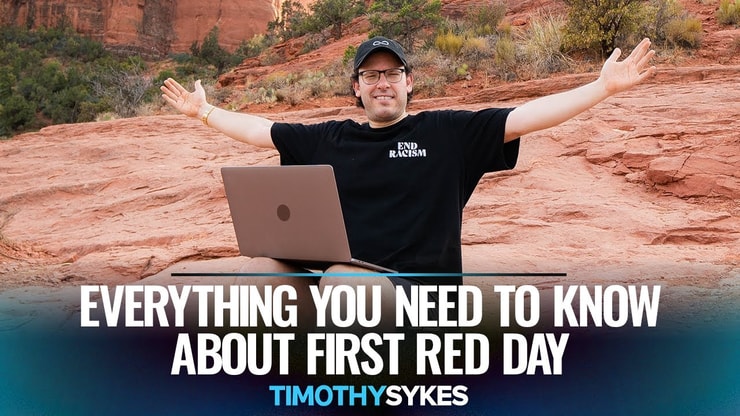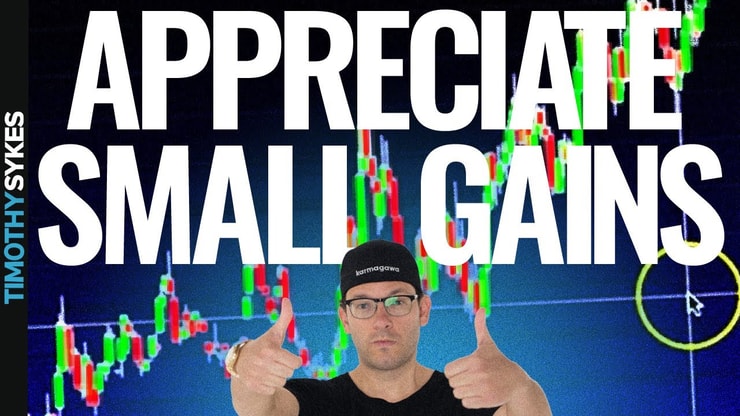My student David is a rare breed — a short seller who doesn’t have a get-rich-quick mentality.
This former college football player embodies the athlete mindset I see in so many top Trading Challenge students. He understood from the start that trading was a long-term prospect. He was willing to put in the ‘training’ time necessary to understand how trading works.
He devoted 10–12 hours to his stock market education on a daily basis while developing his strategy and refining his process. All the while, he supported himself with a warehouse job…
Now, a few years into his trading career, he passed the $100,000 profit mark in March 2021.* Learn all about his intense work ethic and how he made this milestone a reality…
Sooooooooo proud of @yamsayingg for passing $100,000 in profits and he’s just beginning to see what he can accomplish…preparation + opportunity = amazing potential! Stay dedicated my friend https://t.co/0Ofqj91nkY
— Timothy Sykes (@timothysykes) March 26, 2021
Table of Contents
From Confused College Grad to Dedicated Trader
After graduating college in 2016, David had no idea what he was doing with his life.
As a college student, he played football and studied kinesiology. He thought maybe he’d become a coach. But despite a personal interest in sports and fitness, he found he had no passion for it as a career path.
After working random jobs for about a year, he ran into an old friend. The friend had gotten into day trading — he pointed David in my direction.
David had always had a passing interest in the growth potential of the stock market. But when he looked me up, his interest became more active.
He started by joining PennyStocking Silver and watching my videos. That was the beginning…
An Athlete’s Discipline + Insane Work Ethic
It didn’t take long for David to decide that trading was the right direction for him. He decided to go all-in … But he wasn’t stupid about it.
At the time, he was working a personal training job that didn’t work with his trading schedule. He quit, but took a warehouse job — he knew he needed money to support himself and his trading account.
He’d work that job from 3 p.m. until about midnight. Then he’d sleep and wake up at about 5 a.m. Pacific, prepare and trade until about 1 p.m., then go back to work.
When he wasn’t trading, he was studying. While at his warehouse job, he’d wear headphones and listen to my webinars and video lessons as well as StocksToTrade content. (Quick disclaimer: I helped design and develop StocksToTrade and am an investor in it.)
He estimates he was devoting 10–12 hours daily to his stock market education.
That’s a grueling schedule … What kept him going?
A long-term view.
He’d made a conscious decision to pursue trading. He knew it was a marathon, not a sprint — speed wasn’t as important to him as the quality of his education.
David credits his college football career as teaching him a lot about discipline. He’s willing to do something constantly and obsessively over time to see results.
He did the whole warehouse job-and-trading thing for about two years…
I have ZERO compassion for people who have so much damn opportunity & yet do nothing with their lives due to fear of failure/a lack of effort. I’m blessed to have been taught I was capable of achieving anything, but it was my work ethic that actually made all my dreams come true!
— Timothy Sykes (@timothysykes) April 21, 2021
David’s Favorite Trading Education Resources
As he was learning the ropes, David says that my “PennyStocking Framework” DVD was a pivotal educational resource. Through that DVD, he learned and mastered the basis of all of the stock patterns he currently trades.
It’s one thing to know that shorting the first red day is a pattern … My top student Tim Grittani’s DVD “Trading Tickers” helped him understand not just the ‘how’ but the ‘why’ behind it.
“Trading Tickers” clued him in on the thought process and mindset necessary for trading. Observing what Grittani was thinking or why he entered a trade helped David progress from memorizing patterns to actually making them work for him.
NEW BLOG POST: https://t.co/XiPanb0Qiu Tim Grittani’s Great Return: Trading Tickers 2…this new guide is a MUST WATCH as @kroyrunner89 has had one of the most phenomenal runs in the history of trading & it's VERY cool how open he is about his entire process….STUDY HAAAAAAARD!
— Timothy Sykes (@timothysykes) April 19, 2021
Slow But Steady…
I always say that trading is a marathon, not a sprint. David’s story is a great example.
After his initial interest in the stock market in 2017, he figured 2018 would be the year he made it.
It wasn’t.
2019 was better, but not record-breaking. He made about $5,000 that year.* “I didn’t know what was going on,” he shares. He was on the verge of quitting.
David might have, too — if it wasn’t for a friend’s advice…
More Breaking News
- Is Sonnet BioTherapeutics Stock A Hidden Gem?
- Bitmine Immersion Technologies’ Revenue Skyrockets as Stock Price Surges
- D-Wave Quantum Inc. Under Spotlight: What’s Next?
Support From the Trading Challenge Community

Early in his trading journey, David had befriended my Trading Challenge student Jack Kellogg.
They were both coming up as traders — this was way before Jack crossed the million-dollar mark. As of late April 2021, he’s up over $6.4 million in trading profits*…
When David was on the verge of quitting, Jack urged him to stick with it.
It’s hard to overstate the importance of having a strong trading community … That support is so important.
Not only did David stick with trading, but in early 2021, he actually relocated to the east coast and joined Jack in a cooperative trading space. Jack’s currently taking a break to avoid trader burnout, but their friendship remains strong.
I burnt out so many times, but I always kept pushing. Not many people went even close to how hard I went. But now there is a lot of consequences and repercussions for my insane behavior. Health and relationships are my #1 priority & trading is on the backburner.✌ #BALANCE 🙏
— Jack Kellogg (@Jackaroo_Trades) April 18, 2021
David says, “It’s great to see someone who’s ‘made it’ and to observe his process and mindset.”
2020: David’s ‘Aha’ Moment
After nearly quitting, David decided to switch up his strategy.
He explored short selling … It turned out to be a strategy that worked well for him.
By the end of 2019, he was beginning to find his stride. He discovered a few patterns that worked for him. He analyzed his data to really understand which setups and types of stocks gave him his best results.
In 2020, things really started to click for him. He says it was a combination of the market opportunities and sticking to patterns he knew. “I didn’t deviate,” he says — he stuck to shorting first red days and pumps.
All year long, he continued to trade, learn, and refined his process. In 2021, his growth has been exponential…
As of April 2021, he’s already made nearly as much this year as he made during the entire year in 2020. Last month, he passed $100,000 in profits.*
Adapting: David’s Favorite Setups
I mentioned that David likes to stick to his favorite patterns … But he also understands the importance of adapting.
Sadly, too many people do not adapt & they wonder why they aren't successful all the time…welcome to trading, adapt or perish! You wonder why 90% of traders lose? It's due to lack of preparation, lack of adaptation, so your odds of success depends on your knowledge/adaptability
— Timothy Sykes (@timothysykes) April 16, 2021
In general, his favorite setup is the first red day on a multi-day move.
But right now, the market is different. There aren’t many multi-day runners, so he’s looking for the #7 breakdown pattern.
He’s able to see a shift in the market. He shifted his strategy to take advantage of what he can.
David occasionally goes long, but it doesn’t happen often. His stats show him that going short is much better for him, so he sticks with what works.
Trades As Teachers: David’s Ongoing Education
Early on in his trading career, David struggled with losses. He started with a small account, so he felt the impact of every loss. He found it hard to cut losses.
Over time, he learned an important lesson: losses are just part of the game. He tries not to worry about a single loss. He knows that over the course of a month or years, one loss doesn’t have as much impact as small gains adding up.
These days, he tries to learn something from every trade — good and bad…
NeoVolta Inc. (OTCQB: NEOV)
For instance, in 2020, David had his biggest loss.
Between this trade and this trade on NeoVolta Inc. (OTCQB: NEOV), David’s combined losses were approximately $9,000. But after all of the overnight fees on these short swing trades, the realized loss was even bigger.
David hadn’t done anything wrong. It was a pattern he traded all the time — a pump followed by a breakdown. But in this case, the stock never broke down.
This is why cutting losses quickly is SO important…
During the time David held those positions, it ate away at his mental capital. It robbed him of self-confidence and stalled his forward progress.
Finally, he ate the loss … The relief was incredible. Almost immediately after realizing the loss, he rebounded. He made back everything he’d lost within a month or so.*
Bayport International Holdings Inc. (OTCPK: BAYP)
David calls his trade on Bayport International Holdings Inc. (OTCPK: BAYP) “the craziest trade” of his career.
The $749 profit* makes it look like a great trade on paper … But what it doesn’t show is that he was down 200% at one point in the trade.
He admits the trade was all wrong: he was motivated by FOMO. There were warning signs. But he traded it anyway…
Ultimately, things turned around and he made money on the trade. But given the stress he experienced during it, he admits that if he could go back in time, he never would have made that trade.
David’s Next Goals as a Trader

Now that David’s passed this milestone, what are his next goals?
He says it’s to continue to refine his process, “Every day, every trade, I can always do something better.”
Right now, he’s working on sizing up appropriate to his account size and slowly expanding his strategy. For instance, he mostly trades OTCs now, but he’s interested in potentially expanding to Nasdaq stocks.
He’s also working on his psychology — he knows he doesn’t like to lose, so he’s continuing to work on that.
Overall, he plans on continuing to treat trading like a business, not a game.
Are You Disciplined?
Already, David has learned one of the most important lessons in trading…
The most valuable asset for traders isn’t a great brokerage account or a super-fast laptop or even a big account.
It’s experience.
For David, the most valuable trading lessons have been learned over time, from other people, and from learning what patterns work for him.
It’s not easy. It requires time, effort, and a ton of practice.
David was willing to put in grueling hours to build up his ‘knowledge account,’ and now it’s beginning to reflect in his trading.
Are you inspired? Are you ready to follow his lead and pursue your trading education with this kind of determination? If so, consider applying for my Trading Challenge.
Are you willing to learn from your mistakes like David so you can keep getting better? Leave a comment … I love hearing from you!
Disclaimers
*Please note that David’s trading results, as well as Jack Kellogg’s, are not typical. Most traders lose money. It takes years of dedication, hard work, and discipline to learn how to trade. Individual results will vary. Trading is inherently risky. Before making any trades, remember to do your due diligence and never risk more than you can afford to lose. I’ve also hired Jack to help in my education business.
This level of successful trading is not typical and does not reflect the experience of the majority of individuals using the services and products offered on this website. From January 1, 2020, to December 31, 2020, typical users of the products and services offered by this website reported earning, on average, an estimated $49.91 in profit. This figure is taken from tracking user accounts on Profit.ly, a trading community platform. Timothy Sykes has a minority shareholder interest in the platform. The typical success rate of users was based on the following methodology:
- From January 1, 2020, to December 31, 2020, 849,078 trades were uploaded to Profit.ly. 633,891 trades were “verified” (corroborated with trade account data).
- Instructor trades are ignored.
- Average P&L / trades is obtained by calculating total P&L and dividing by the total number of trades
- Average trades per account is obtained by counting the total number of trades and dividing by the number of accounts (mean function)












Leave a reply